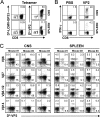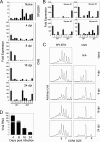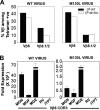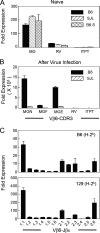Predominant clonal accumulation of CD8+ T cells with moderate avidity in the central nervous systems of Theiler's virus-infected C57BL/6 mice
- PMID: 20071578
- PMCID: PMC2826044
- DOI: 10.1128/JVI.01948-09
Predominant clonal accumulation of CD8+ T cells with moderate avidity in the central nervous systems of Theiler's virus-infected C57BL/6 mice
Abstract
Induction of antigen-specific CD8(+) T cells bearing a high-avidity T-cell receptor (TCR) is thought to be an important factor in antiviral and antitumor immune responses. However, the relationship between TCR diversity and functional avidity of epitope-specific CD8(+) T cells accumulating in the central nervous system (CNS) during viral infection is unknown. Hence, analysis of T-cell diversity at the clonal level is important to understand the fate and function of virus-specific CD8(+) T cells. In this study, we examined the Vbeta diversity and avidity of CD8(+) T cells specific to the predominant epitope (VP2(121-130)) of Theiler's murine encephalomyelitis virus. We found that Vbeta6(+) CD8(+) T cells, associated with epitope specificity, predominantly expanded in the CNS during viral infection. Further investigations of antigen-specific Vbeta6(+) CD8(+) T cells by CDR3 spectratyping and sequencing indicated that distinct T-cell clonotypes are preferentially increased in the CNS compared to the periphery. Among the epitope-specific Vbeta6(+) CD8(+) T cells, MGX-Jbeta1.1 motif-bearing cells, which could be found at a high precursor frequency in naïve mice, were expanded in the CNS and tightly associated with gamma interferon production. These T cells displayed moderate avidity for the cognate epitope rather than the high avidity normally observed in memory/effector T cells. Therefore, our findings provide new insights into the CD8(+) T-cell repertoire during immune responses to viral infection in the CNS.
Figures







Similar articles
-
The majority of infiltrating CD8+ T cells in the central nervous system of susceptible SJL/J mice infected with Theiler's virus are virus specific and fully functional.J Virol. 2002 Jul;76(13):6577-85. doi: 10.1128/jvi.76.13.6577-6585.2002. J Virol. 2002. PMID: 12050370 Free PMC article.
-
Differences in avidity and epitope recognition of CD8(+) T cells infiltrating the central nervous systems of SJL/J mice infected with BeAn and DA strains of Theiler's murine encephalomyelitis virus.J Virol. 2002 Nov;76(22):11780-4. doi: 10.1128/jvi.76.22.11780-11784.2002. J Virol. 2002. PMID: 12388742 Free PMC article.
-
Rapid formation of extended processes and engagement of Theiler's virus-infected neurons by CNS-infiltrating CD8 T cells.Am J Pathol. 2010 Oct;177(4):1823-33. doi: 10.2353/ajpath.2010.100231. Epub 2010 Sep 2. Am J Pathol. 2010. PMID: 20813972 Free PMC article.
-
Theiler's virus-mediated autoimmunity: local presentation of CNS antigens and epitope spreading.Ann N Y Acad Sci. 2002 Apr;958:26-38. Ann N Y Acad Sci. 2002. PMID: 12021081 Review.
-
Virus-induced autoimmunity: epitope spreading to myelin autoepitopes in Theiler's virus infection of the central nervous system.Adv Virus Res. 2001;56:199-217. doi: 10.1016/s0065-3527(01)56008-x. Adv Virus Res. 2001. PMID: 11450300 Review.
Cited by
-
Contrasting roles for CD4 vs. CD8 T-cells in a murine model of virally induced "T1 black hole" formation.PLoS One. 2012;7(2):e31459. doi: 10.1371/journal.pone.0031459. Epub 2012 Feb 13. PLoS One. 2012. PMID: 22348089 Free PMC article.
-
The level of viral infection of antigen-presenting cells correlates with the level of development of Theiler's murine encephalomyelitis virus-induced demyelinating disease.J Virol. 2015 Feb;89(3):1867-78. doi: 10.1128/JVI.02471-14. Epub 2014 Nov 26. J Virol. 2015. PMID: 25428872 Free PMC article.
-
Clonal expansions of CD8+ T cells with IL-10 secreting capacity occur during chronic Mycobacterium tuberculosis infection.PLoS One. 2013;8(3):e58612. doi: 10.1371/journal.pone.0058612. Epub 2013 Mar 5. PLoS One. 2013. PMID: 23472214 Free PMC article.
-
Epitope-specific CD8+ T cells play a differential pathogenic role in the development of a viral disease model for multiple sclerosis.J Virol. 2012 Dec;86(24):13717-28. doi: 10.1128/JVI.01733-12. Epub 2012 Oct 10. J Virol. 2012. PMID: 23055563 Free PMC article.
-
Antigen-Specificity of T Cell Infiltrates in Biopsies With T Cell-Mediated Rejection and BK Polyomavirus Viremia: Analysis by Next Generation Sequencing.Am J Transplant. 2016 Nov;16(11):3131-3138. doi: 10.1111/ajt.13911. Epub 2016 Jul 15. Am J Transplant. 2016. PMID: 27273900 Free PMC article.
References
-
- Alexander-Miller, M. A. 2005. High-avidity CD8+ T cells: optimal soldiers in the war against viruses and tumors. Immunol. Res. 31:13-24. - PubMed
-
- Altman, J. D., P. A. Moss, P. J. Goulder, D. H. Barouch, M. G. McHeyzer-Williams, J. I. Bell, A. J. McMichael, and M. M. Davis. 1996. Phenotypic analysis of antigen-specific T lymphocytes. Science 274:94-96. - PubMed
-
- Babbe, H., A. Roers, A. Waisman, H. Lassmann, N. Goebels, R. Hohlfeld, M. Friese, R. Schroder, M. Deckert, S. Schmidt, R. Ravid, and K. Rajewsky. 2000. Clonal expansions of CD8(+) T cells dominate the T cell infiltrate in active multiple sclerosis lesions as shown by micromanipulation and single cell polymerase chain reaction. J. Exp. Med. 192:393-404. - PMC - PubMed
-
- Blackman, M. A., H. Gerhard-Burgert, D. L. Woodland, E. Palmer, J. W. Kappler, and P. Marrack. 1990. A role for clonal inactivation in T cell tolerance to Mls-1a. Nature 345:540-542. - PubMed
Publication types
MeSH terms
Substances
Grants and funding
LinkOut - more resources
Full Text Sources
Research Materials

